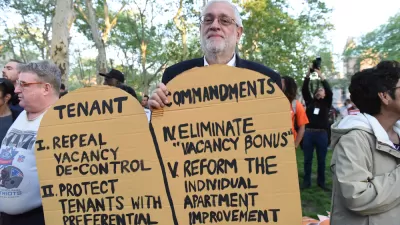A June 7 ballot measure in Richmond, California would permit 59 single family homes to be built on a 5-acre bayfront lot within walking distance to a future ferry landing for San Francisco service. The site is zoned for high-density housing.

Developer and landowner Richard Poe, founder of Virtual Development Corporation, opposes building high-density apartments on his property, so he has qualified an initiative, "Riveria Project" (Measure N) to get voter approval on Tuesday to permit the low density project to bypass Richmond's general plan.
The measure "is the focus of a fierce political battle over how much housing will get built in the East Bay city" of 107,000, writes Rachel Swan, who covers Oakland and the surrounding East Bay cities for the San Francisco Chronicle. Richmond is in Contra Costa County.
Poe’s Measure N would loosen the city’s general plan that calls for high-density apartments and office buildings near transit corridors so that his project could sail through.
The Richmond ferry terminal, to be built by the San Francisco Bay Area Water Emergency Transportation Authority (WETA), is scheduled to open in 2018. The limited service to and from San Francisco, approved by WETA in March 2015, will be subsidized by the Contra Costa Transportation Authority (CCTA) and the City of Richmond.
“The development he’s proposed is totally inappropriate,” said Mayor Tom Butt, who has donated $2,500 to defeat Measure N. “It’s basically a suburban, almost rural project in an area that should be focused on high-intensity building.”
"The measure calls for altering the city's general plan — a document that took years of work and reflects the input of thousands of Richmond residents — to suit Poe's desires," wrote John Geluardi for the East Bay Express on Nov. 11, 2015 when Poe announced his intention to bypass the city approval process and gather signatures.
For decades, large, dense developments have bypassed Richmond, while cities like San Francisco, Oakland, Emeryville, and Berkeley have undergone revenue-generating building booms. That's why the Richmond general plan designated Poe's five-acre site as "high intensity mixed use" and zoned the site for structures of up to 135 feet and residential density of up to 625 units. But Poe wants to build 59 expensive, single-family homes with a maximum height of 35 feet.
Poe's activism didn't stop with Measure N. He also qualified Measure O for Tuesday's ballot which would limit the pay of the city manager. Mayor Butt opined in The Richmond Standard that the measure was done as an act of "collateral spite towards City staff who did not embrace his project."
Also on the June 7 ballot in the Bay Area is the first 9-county regional measure, AA, that calls for an annual $12 parcel tax for wetland restoration that would also mitigate coastal flooding and sea level rise.
Correspondent's notes: The Chronicle article may not be accessible without subscription. Please click on East Bay Express and The Richmond Standard for more information on the two measures.
In addition to above links to Ballotpedia, see the city of Richmond webpage for June 7 ballot measures and potential Nov. 8 ballot measures.
FULL STORY: Richmond fights for apartments; developer wants ‘Riviera’ homes

Study: Maui’s Plan to Convert Vacation Rentals to Long-Term Housing Could Cause Nearly $1 Billion Economic Loss
The plan would reduce visitor accommodation by 25,% resulting in 1,900 jobs lost.

Alabama: Trump Terminates Settlements for Black Communities Harmed By Raw Sewage
Trump deemed the landmark civil rights agreement “illegal DEI and environmental justice policy.”

Why Should We Subsidize Public Transportation?
Many public transit agencies face financial stress due to rising costs, declining fare revenue, and declining subsidies. Transit advocates must provide a strong business case for increasing public transit funding.

Paris Bike Boom Leads to Steep Drop in Air Pollution
The French city’s air quality has improved dramatically in the past 20 years, coinciding with a growth in cycling.

Why Housing Costs More to Build in California Than in Texas
Hard costs like labor and materials combined with ‘soft’ costs such as permitting make building in the San Francisco Bay Area almost three times as costly as in Texas cities.

San Diego County Sees a Rise in Urban Coyotes
San Diego County experiences a rise in urban coyotes, as sightings become prevalent throughout its urban neighbourhoods and surrounding areas.
Urban Design for Planners 1: Software Tools
This six-course series explores essential urban design concepts using open source software and equips planners with the tools they need to participate fully in the urban design process.
Planning for Universal Design
Learn the tools for implementing Universal Design in planning regulations.
Smith Gee Studio
Alamo Area Metropolitan Planning Organization
City of Santa Clarita
Institute for Housing and Urban Development Studies (IHS)
City of Grandview
Harvard GSD Executive Education
Toledo-Lucas County Plan Commissions
Salt Lake City
NYU Wagner Graduate School of Public Service





























